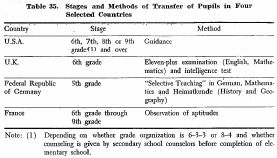| Home > Policy > White Paper, Notice, Announcement > White Paper > EDUCATIONAL STANDARDS IN JAPAN 1965 > CHAPTER |
||
An important problem now under study in the major countries of the world is that of how to provide education suited to the individual abilities and aptitudes of students.
In Japan, the lower secondary school curriculum was revised in 1958, aiming at providing education commensurate with individual abilities and aptitudes. In accordance with this objectives, the number of elective subjects was increased, especially in the second and third years, and consequently students were allowed to choose from many elective subjects. The curriculum for upper secondary schools was also reorganized under the same objectives in 1960 so as to enable students to make proper selection of course in accordance with their abilities, aptitudes, interests and future plans and providing a variety of patterns or curricula.
The Ministry of Education has made various efforts to develop the guidance program. The in-service training program on guidance and counselling has been organized for principals and teacher-consultants of lower and upper secondary schools since 1963. Both the estab1ishment of pilot schools for the improvement of guidance and councelling and the creation of teacher-consultants in charge of guidance (counselors) were effected in 1964. In spite of such efforts made by the Ministry of Education to develop guidance and counselling, the present status is not yet adequate to assure education best suited to pupils' abilities and aptitudes.
Procedures for the allocation of pupils to courses in secondary schools which are practiced by the main countries will be considered in the following in connection with the education suited to abilities and aptitudes. It will be suggestive for the future plan of our country.

Table 35 shows the periods and methods of transfer from elementary to secondary schools and assignment to secondary school classes in four selected countries. In the Union of Soviet Socialist Republics, allocation does not take place during compulsory education. After that, four types of secondary schools are provided. Admission to secondary schools, except specialized secondary schools which give entrance examinations, depends on the various conditions of schools and applicants' needs.
| Back to Top | MEXT HOME |